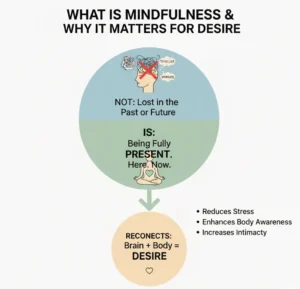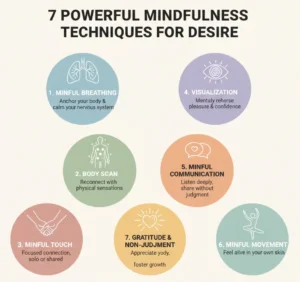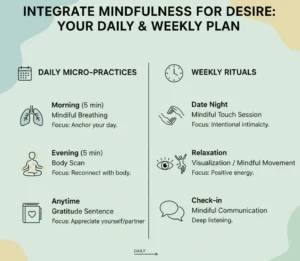Let’s be real — desire isn’t always there when we want it to be.
Sometimes you love your partner deeply, but your body feels… disconnected.
Or maybe you crave intimacy, yet stress, fatigue, or that endless mental checklist keep you distracted.
I’ve been there. And I’ve talked to dozens of clients who whisper the same thing: “I want to feel that spark again, but I just don’t.”
That’s where mindfulness techniques for desire come in.
Mindfulness isn’t about forcing arousal or meditating your way into passion. It’s about learning to be present — in your body, in the moment, with your partner. When you slow down and pay attention, your natural desire begins to resurface.
Table of Content
What Is Mindfulness — and Why It Matters for Desire

At its simplest, mindfulness is the practice of being fully present. You’re not lost in yesterday’s worries or tomorrow’s to-do list. You’re here, right now. And that matters hugely when we talk about mindfulness techniques for desire.
Research shows that higher mindfulness correlates with better sexual function. For example, one large study found that women with greater trait mindfulness had significantly higher sexual function scores and lower sexual distress. In short, mindfulness reconnects the brain and the body, which is the foundation of sexual desire.
In short, mindfulness reconnects the brain and the body, which is the foundation of sexual desire.
My Wake-Up Call
A few years ago, I went through a phase where my own desire had flatlined. Between deadlines, late-night emails, and sheer exhaustion, intimacy felt like one more task on my list.
One night, I tried something simple — a few mindfulness techniques for desire that I’d once read about. I started with deep breathing while touching my own hand, noticing the warmth, the texture, the tingling sensation. It sounds tiny, but that’s where it began. I realized I’d been living in my head for too long.
That single moment of presence, that mindful breath, was the first step toward rediscovering my own sensuality — and proof that sometimes the smallest mindfulness techniques for desire can awaken something powerful within.
Why Desire Fades (and It’s Not Your Fault)
Before diving into techniques, let’s clear one thing up — losing desire doesn’t mean something’s “wrong” with you.
Modern life pulls us in a thousand directions. Stress, sleep deprivation, hormonal shifts, and relationship tension — all of these affect how your body and mind respond to intimacy. That’s why learning a few mindfulness techniques for desire can make such a difference. They help you slow down, reconnect with your body, and quiet the noise that often blocks arousal.
If you haven’t yet, I highly recommend reading Understanding Female Desire. It explains how complex, emotional, and beautifully layered desire really is.
Desire isn’t a switch you turn on; it’s a spark you nurture through awareness, connection, and care — and mindfulness techniques for desire can help you reignite that spark from the inside out.
The 7 Most Powerful Mindfulness Techniques for Desire
Let’s explore some truly practical, research-backed, and heart-centered techniques to help you reconnect with desire — whether for yourself or with your partner. These are real mindfulness techniques for desire you can try.

1. Mindful Breathing to Ground the Body
Sounds simple, right? But it’s powerful.
Take a few deep breaths — slowly, deeply, through your nose. Feel your belly rise and fall. This is your anchor.
When you breathe mindfully, your nervous system shifts from stress mode (fight or flight) to relaxation (rest and digest). That calm state is where desire naturally grows.
Try this before intimacy:
Sit or lie comfortably.
Inhale for 4 seconds, exhale 6.
Focus on the breath touching your skin.
Let go of thoughts.
Within minutes, your body feels lighter, warmer, more open.
2. The Body Scan of Sensual Awareness
This one’s a total game-changer.
A mindful body scan helps you reconnect with physical sensations that daily stress tends to numb out.
Start from the top of your head and move down slowly — notice your face, neck, shoulders, chest, belly, thighs… all the way to your toes.
Don’t judge what you feel; just notice. Tingling, warmth, tightness — it’s all information.
You can even do this with your partner. Turn it into a bonding ritual where you both take turns describing sensations. It’s not about arousal at first — it’s about awareness.
3. Mindful Touch — Solo or Shared
Here’s where things get deliciously real.
Mindful touch means focusing entirely on the act of touching — the skin, the movement, the connection. No pressure for it to “lead” anywhere.
Touch your arm. Feel the texture, the softness, the temperature. Notice how your body responds.
When practiced with a partner, it becomes a silent language of intimacy. Try slow, intentional caresses without rushing toward sex. You’ll be amazed at how your body starts to awaken naturally.
(You might also love reading Benefits of Regular Intimacy for Women to see how consistent closeness strengthens both physical and emotional desire.)
4. Visualization for Desire
Close your eyes and imagine a memory — a moment when you felt desired, confident, and fully alive.
Visualization activates the same neural pathways as real experience. It helps the brain associate relaxation and pleasure with your body again.
If you’ve struggled with performance anxiety or disconnection, this simple mental rehearsal can rebuild positive sexual energy.
5. Mindful Communication
Let’s be honest — desire often fades when communication breaks down.
Mindfulness in communication means listening without planning your next response. It’s about being present with what your partner is saying.
Try asking, “How do you feel when we’re close?” instead of “Why don’t we have sex anymore?”
This approach creates emotional safety, and when emotional safety grows, physical desire often follows.
If you want to dive deeper into this, check out How to Create a Sex-Positive Relationship.
6. Mindful Movement
Yoga, slow dancing, even walking can awaken sensual awareness. Movement isn’t just exercise — it’s a way of feeling alive in your body.
When you stretch, sway, or dance mindfully, you reconnect to the physical joy of being in your own skin.
It doesn’t matter if you’re flexible or fit. What matters is presence.
7. Gratitude and Non-Judgment
This might sound unexpected, but gratitude has a huge role in sexual wellness.
When you practice gratitude for your body — even for its imperfections — you shift from self-criticism to appreciation. That mindset creates space for desire to grow naturally.
You can journal a few lines daily:
“I’m grateful for how my body feels after a warm shower.”
“I love the way my partner’s hand feels on my back.”
Simple, yes, but deeply transformative.
Science Behind Mindfulness and Desire
Using mindfulness techniques for desire isn’t just feel-good fluff. There’s strong evidence behind it.
A study found that group mindfulness-based therapy significantly improved sexual desire and arousal in women with low desire.
Another randomized trial showed improvements in sexual desire, arousal, and reduced distress in women after mindfulness-based therapy.
According to Dr. Lori A. Brotto, mindfulness helps us become more aware of bodily sensations, and that awareness improves sexual desire.
Key mechanisms:
Reduces anxiety and over-thinking during intimacy.
Enhances body awareness and sensitivity.
Increases emotional connection and satisfaction.
How to Integrate These Mindfulness Techniques for Desire into Daily Life

Here’s a simple plan to make them part of your day.
Pick one technique (say mindful breathing) and practice for 5 minutes each morning for a week.
Then add the body scan in the evening.
Have a weekly “mindful touch” session with your partner.
Use visualization when you’re relaxed.
During conversation, practise mindful communication.
On a walk, move with awareness.
At day’s end, write one gratitude sentence.
Slow, steady, consistent. That’s the magic.
When Desire Feels Blocked
Sometimes, even the best mindfulness techniques for desire bring up deeper truths — things like unresolved trauma, hormonal imbalances, or emotional pain. And that’s okay.
If mindfulness makes you realize there’s more beneath the surface, that’s not failure. It’s awareness. It’s your body and mind saying, “Hey, let’s heal this.”
If you suspect that’s part of your story, it’s completely valid to seek help. Read Talk to Your Doctor About Low Sexual Desire for gentle, step-by-step guidance on how to approach professionals without shame or fear.
You deserve a full, satisfying sexual life. There’s no weakness in asking for support — it’s one of the most mindful things you can do for yourself.
Supporting a Partner Who’s Struggling with Desire
If your partner’s the one feeling distant, mindfulness techniques for desire can help you bridge that gap together.
Instead of taking the change personally, practice mindful empathy. Slow down. Listen without judgment. Ask gentle questions like, “What helps you feel connected right now?” or “How can I support you without pressure?”
These mindful approaches create space for honesty and emotional closeness — both essential for rebuilding desire.
For more practical advice, check out Ways to Support a Partner with Low Sexual Desire. Sometimes, just being quietly present is the most powerful act of love you can offer.
Don’t Forget the Basics
Here’s the truth: mindfulness techniques for desire work best when your body feels safe, rested, and nourished.
Sleep, nutrition, hydration, and stress management all affect how your body responds to intimacy. It’s nearly impossible to feel turned on when you’re exhausted, anxious, or running on caffeine and chaos.
The link between rest and arousal is stronger than most people realize — see Impact of Sleep Quality on Sexual Desire.
So before you try to reignite the spark, ask yourself: “Have I rested? Have I eaten something nourishing? Have I taken a moment just to be?”
These small acts of self-care make mindfulness feel more natural — and desire, more accessible.
Desire Isn’t Lost — It’s Waiting
If there’s one lesson mindfulness techniques for desire teach us, it’s this: you don’t find desire by chasing it — you rediscover it by slowing down and coming home to yourself.
Desire never truly disappears. It’s just buried under life’s noise — work, worries, screens, to-do lists. Mindfulness clears that clutter so you can feel again.
Through breath, touch, awareness, and compassion, you can awaken that part of yourself that’s been quietly waiting all along.
So tonight, take a slow breath. Feel your heartbeat. Let the world fade for a moment.
Be here, now — because that’s where desire lives.
FAQs About Mindfulness Techniques for Desire
1. What are mindfulness techniques for desire?
Mindfulness techniques for desire are practices like deep breathing, body scans, and mindful touch that help you reconnect with your body and emotions. They reduce stress, enhance awareness, and make intimacy feel more natural and fulfilling.
2. Can mindfulness really increase sexual desire?
Yes. Studies show that regular mindfulness practice can reduce anxiety and increase body confidence, which directly supports healthy sexual desire.
3. How long does it take for mindfulness to improve desire?
It varies, but many people notice changes in awareness and relaxation within a few weeks of consistent practice.
4. Can couples practice mindfulness together?
Absolutely. Try mindful touch, breathing together, or simply maintaining eye contact during intimacy. Shared mindfulness strengthens emotional and physical connection.
5. What if mindfulness doesn’t help?
If you’ve practiced consistently and still struggle, it’s okay to consult a healthcare provider. Mindfulness complements medical and emotional support — it’s not a replacement.




